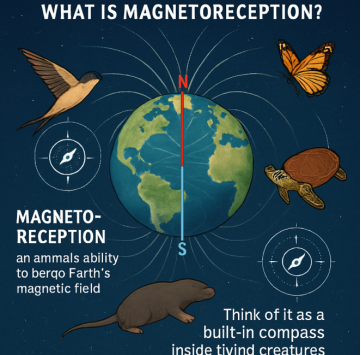How Animals Navigate: Magnetoreception and Beyond
How Animals Navigate: Magnetoreception and Beyond
Imagine being able to find your way home blindfolded — across continents, oceans, and vast landscapes — without a map, GPS, or even a compass. For many animals, this incredible feat is part of everyday life. From tiny migrating monarch butterflies to giant sea turtles crossing thousands of miles of open ocean, animals possess extraordinary navigation skills that continue to baffle and fascinate scientists.
So how do they do it? Beyond the familiar senses like sight, smell, and hearing, many animals harness an invisible, mysterious sixth sense called magnetoreception — the ability to detect Earth’s magnetic field. But that’s just the beginning. This blog dives into the hidden world of animal navigation, unveiling secrets of magnetoreception and the remarkable strategies animals use to find their way.
The Invisible Compass: What Is Magnetoreception?
Earth behaves like a giant magnet with magnetic field lines running from the North to the South Pole. This magnetic field is weak but stable, providing a constant reference point — a natural GPS in the sky. Magnetoreception is an animal’s ability to sense this magnetic field and use it to orient and navigate.
Think of it as a built-in compass inside living creatures.
Who’s Got the Magic Compass? Animals That Use Magnetoreception
The list of magnetoreceptive animals is astonishingly diverse:
Migratory Birds: Pigeons, robins, and songbirds travel thousands of kilometers, crossing continents and oceans. They use magnetoreception to stay on course even on cloudy days or when landmarks vanish.
Sea Turtles: Hatchlings find their way to the ocean, and adults return decades later to the very beach where they were born.
Salmon: These fish navigate back from the ocean to their natal freshwater streams with remarkable accuracy.
Insects: Bees and monarch butterflies use magnetic cues combined with sunlight to migrate and forage efficiently.
Mammals: Some bats and mole rats are believed to detect magnetic fields for navigation underground or at night.
Each species may use the magnetic field differently, but the end result is the same: accurate, long-distance navigation.
How Does Magnetoreception Work? The Science Behind the Mystery
Despite decades of research, magnetoreception remains one of nature’s best-kept secrets. Scientists propose two primary mechanisms:
1. The Magnetite Hypothesis: Nature’s Tiny Magnets
Some animals have minuscule crystals of magnetite — a naturally magnetic mineral — embedded in their tissues, often near nerve cells. These tiny magnets physically align with Earth’s magnetic field, producing mechanical signals the brain can interpret as directional information.
Did you know? Magnetite crystals have been found in the beaks of pigeons and the noses of some fish, suggesting a biological compass.
2. The Radical Pair Mechanism: Magnetic Vision
Another mind-blowing hypothesis involves a protein called cryptochrome found in the eyes of birds and some insects. This protein reacts to blue light, creating pairs of molecules with unpaired electrons (radicals) whose spins can be influenced by magnetic fields.
The theory suggests animals might “see” magnetic fields as visual patterns or overlays — essentially a magnetic map superimposed on their normal vision.
Real-Life Navigators in Action
The Homing Pigeon: The Original Navigator
Homing pigeons have been used for centuries to deliver messages, but their secret navigation abilities baffled scientists. Experiments show pigeons can find their way home even when released hundreds of kilometers away in unfamiliar locations — sometimes relying on magnetic cues, alongside smells and landmarks.
The Loggerhead Sea Turtle: Ocean Wanderer
Loggerhead turtles hatch on sandy beaches and immediately head to the open ocean. Over decades, they travel thousands of miles, then return to the exact beach to lay their own eggs. Researchers believe turtles use magnetic signatures unique to specific coastal areas, enabling precise homing.
The Monarch Butterfly: Epic Migrator
Every fall, millions of monarch butterflies embark on a journey up to 4,000 kilometers from North America to central Mexico. They use a combination of the sun’s position and magnetoreception to stay on course — a journey that spans multiple generations.
Beyond Magnetoreception: The Full Toolbox of Animal Navigation
While magnetoreception is incredible, it’s only one tool in an animal’s navigation kit. Animals also rely on:
Sun and Stars: Many animals use the sun during the day and stars at night to orient themselves.
Olfactory Maps: Salmon use unique chemical signatures in their natal rivers to find their way home.
Visual Landmarks: Birds and mammals remember mountains, rivers, and other terrain features.
Echolocation: Bats and dolphins emit sound waves and listen to the echoes to “see” their surroundings.
Why Does Understanding Animal Navigation Matter?
Studying these navigation systems is more than just scientific curiosity:
Conservation: Knowing migratory routes helps protect endangered species.
Technology: Nature inspires innovations — imagine drones or robots navigating using magnetic fields like animals.
Fundamental Science: Unraveling these mysteries reveals how life evolved extraordinary sensory abilities.
The Future: Unlocking Nature’s Compass
Magnetoreception remains a puzzle with many missing pieces. New technologies, such as genetic editing and advanced imaging, are helping scientists probe deeper. Could humans one day develop magnetic senses? Could this lead to revolutionary navigation devices?
The invisible compass inside animals is a captivating example of nature’s ingenuity — a reminder that the world around us holds secrets still waiting to be discovered.
Curious to learn more about animal superpowers?
Stay tuned for upcoming posts on echolocation, bio-luminescence, and the chemistry behind animal senses!
Visit Instagram Profile :
https://www.instagram.com/vichemblogs?igsh=MXEzemhtYWgxNng4Nw==
Let’s Talk
What sparked your curiosity?
Drop a comment on the blog or connect with me on LinkedIn.
Follow & Explore More at VishalChem
https://dabhivishal1668.blogspot.com
To know more about this visit the About Page.
You might like following Topics
1. Obssesive Chemistry : How Molecules Shape the Mind in OCD
2. You’re Made of Stardust: The Chemistry Behind Your Cosmic Origins
3. The Art of Web Weaving: How Spiders Create Their Masterpieces and the Chemistry Behind It
4. The Chemical Secrets of Chameleon Camouflage: Nature's Molecular Masterpiece






Comments
Post a Comment